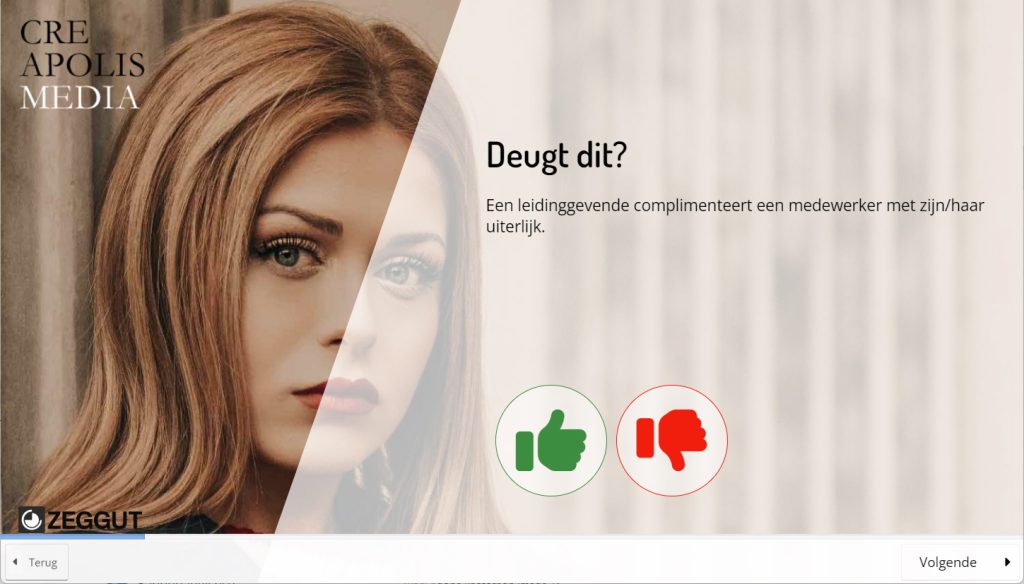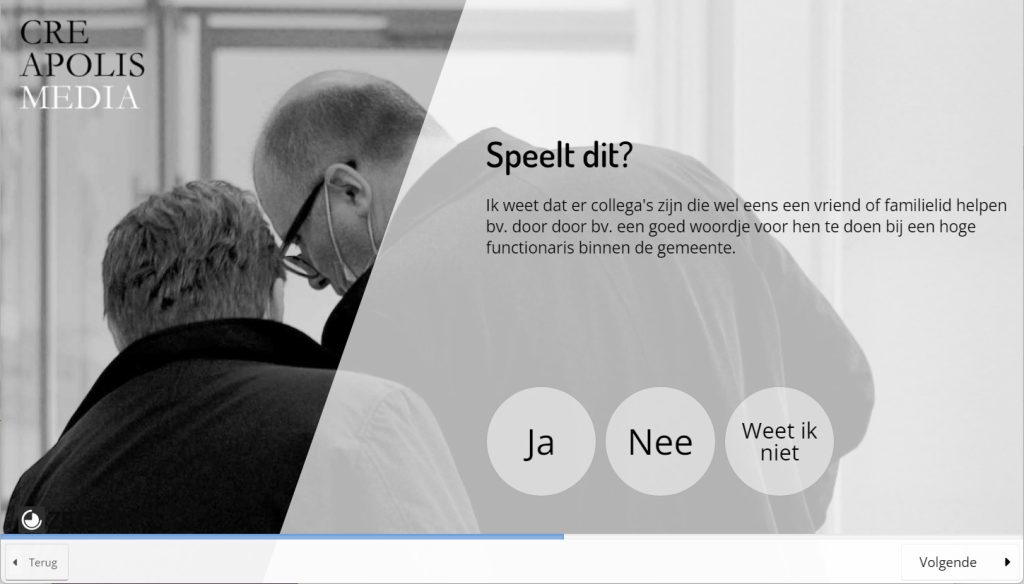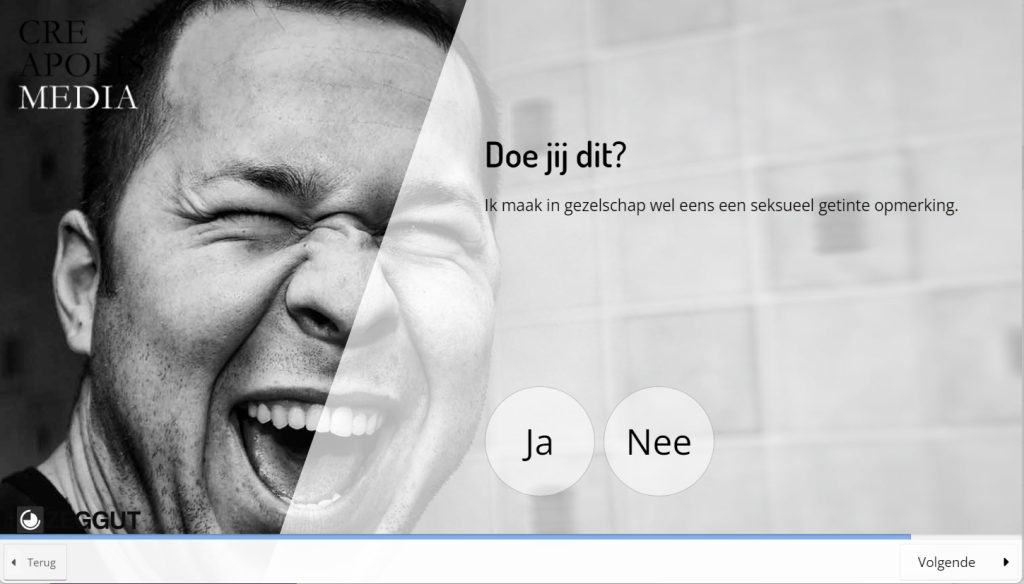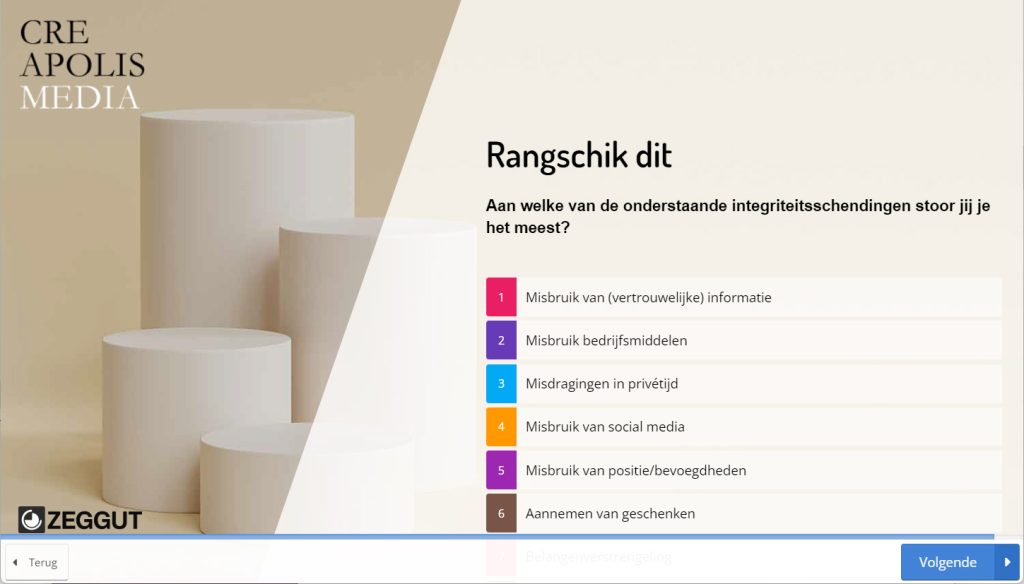TELLUZ
How ethical is your organization?
The Telluz scan
Round 1 – Is this appropriate?
In the first round of the Telluz scan, a number of behavioral examples are presented to the participant. These describe specific situations in which a person (or people) behaves in a certain way. After each example, the participant is asked, “Is this appropriate?” In other words, “Is this behaviour acceptable?”
The participant now has two response options:
- ‘Thumbs up’ if they find the behavior in the example acceptable.
- ‘Thumbs down’ if they find the behavior unacceptable.
Using thumbs as symbols of approval or disapproval is a simple and quick way to gather feedback without participants having to provide extensive explanations.
The purpose of this round is to get a general understanding of the participants’ norms and values regarding certain behaviours and to gain insight into what is considered socially acceptable and unacceptable in the context of the given examples.
The collected feedback provides valuable information for further discussions, decision-making, or policy development. It also helps identify behaviours that are generally considered inappropriate and may need to be avoided or adjusted in a specific context
Round 2 – Does This Happen?
In the second round of the scan, the participant, gets to see another set of behavioural examples similar to the first round. These examples describe specific situations in which a person behaves in a certain way. After each example, the participant is asked, “Does this happen?” In other words, “Does this behaviour occur in your work environment, with colleagues and/or supervisors behaving in this way?”
The participant now has three response options:
- ‘Yes’: If they have observed that colleagues and/or supervisors exhibit such behavior in their work environment.
- ‘No’: If they are certain that this specific behavior does not occur among colleagues and/or supervisors.
- ‘I don’t know’: If they are unsure if they have observed such behavior or if they lack sufficient information to answer with certainty.
The goal of this round is to determine whether the behaviour from the examples actually occurs in practice. This helps gain a better understanding of the real situation within the work environment and to discover any discrepancies between what was considered acceptable and unacceptable in the first round and what is actually observed in daily practice. By asking about observed behaviour among colleagues and supervisors, participants can emphasise the actual behavioural norms within their organisation or group. This information can help identify potential discrepancies between desired norms and actual practice, and can provide starting points for addressing any behavioural issues or strengthening positive aspects of the organisational culture.
Similar to the first round, the feedback in the second round provides valuable insights into the prevailing behaviour in the work environment, particularly concerning the presented behavioural examples.
Round 3 – Have you done this yourself?
In the third and final round of the scan, behavioural examples are presented to the participants once again, similar to the previous rounds. After each example, the participant is asked, “Have you done this yourself?”
The participant now has two response options:
- ‘Yes’ if they acknowledge behaving in a similar manner.
- ‘No’ if they indicate that they have not engaged in such behavior.
This round is intended to promote participants to reflect and to help them honestly evaluate whether they engage in behaviours that were previously considered acceptable or unacceptable. The goal to raise awareness of their own behaviour and to examine to whether participants adhere to the behavioural norms set.
The value of this third round depends, of course, on the honesty of the participants. Some participants may find it challenging to admit they do not always act with integrity, especially if the behaviour is judged negatively. Social desirability may come into play, where participants may be inclined to present themselves in a more positive light than their actual behaviour.
To encourage honest answers, it is essential that the process is conducted in a safe and confidential manner. Participants should feel comfortable being open and truthful without fear of repercussions. The guaranteed anonymity provided by a Telluz scan will undoubtedly contribute to honest self-evaluations.
It is important to emphasise that the purpose of this round is not to condemn or punish participants for potentially less honourable behaviour but rather to promote awareness and openness. Honest self-evaluation can lead to self-improvement and growth, laying the groundwork for positive behavioural changes in the future.
Round 4 – Rank this
In the final round of the scan, various interventions are presented to the participants as potential measures to enhance the organisation’s integrity. These interventions can range from training programmes and policy measures to specific behavioural guidelines and ethical codes.
The participant has to rank these interventions in order of desirability. They have to drag and drop the interventions in a specific sequence, indicating which intervention is deemed most suitable for contributing to the improvement of the organisation’s integrity and which is considered least suitable.
By asking participants to rank the interventions, they are encouraged to contemplate the relative effectiveness and impact of each proposed measure. It compels them to prioritise and consider which interventions would have the most significant positive influence in promoting an ethical culture within the organisation.
This approach provides a structured way to gather valuable input from different participants and gain insights into which interventions are perceived as most valuable by the group as a whole. It can help identify consensus on which steps should be taken to enhance the integrity level and lay the groundwork for developing a targeted action plan.




